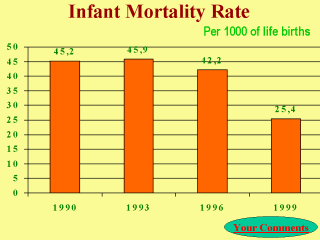| front |1 |2 |3 |4 |5 |6 |7 |8 |9 |10 |11 |12 |13 |14 |15 |16 |17 |18 |19 |review |
 |
Infant mortality
levels have fallen significantly over the last 10 years but are still high and remain a
cause for concern. Acute respiratory infections (ARI) are the first cause of infant
mortality followed by perinatal conditions and diarrhoeal diseases. Increasing air
pollution and poor water quality, especially in rural areas is a contributing factor to
this situation. The infant mortality rate in 1997 was 37.1 per 1000 births, compared to 45.2 in 1990. The main cause of infant mortality is ARI and diarrhoea. Maternal mortality continues to be high at about 82 per 100,000 live births and over 70 percent of women suffer from anaemia and iron deficiency. The highest level of maternal mortality is found in the 20-24 age group, notably in Dashkhovuz velayat. Higher than desired levels of infant and maternal mortality continues to be a matter of concern in Turkmenistan though the birth rate has declined considerably over the years. The mortality rate appears to be increasing by age particularly among men. Lowest mortality is observed at age 10-14 years and thereafter the rate increases with age. The productive years of 29-39 years show higher mortality rates, largely industrial and non-industrial accidents and circulatory system diseases. Mortality during 40-59 years is also slightly higher, largely due to the exposure of this cohort to wars, devastation and difficult post-war years. |